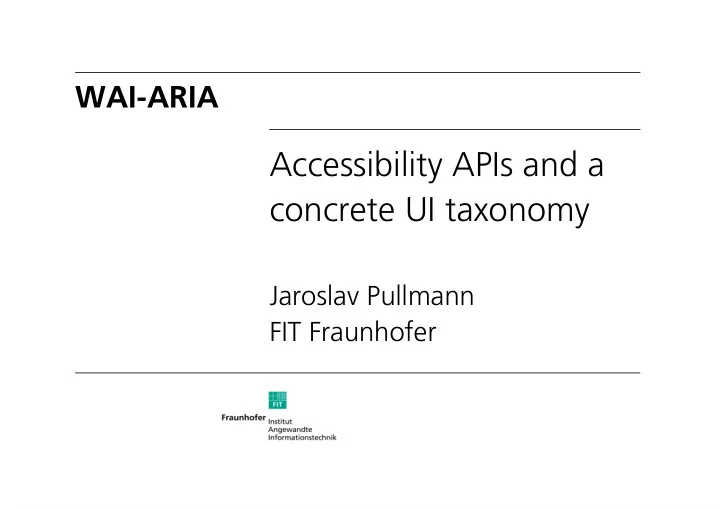

WAI-ARIA Accessibility APIs and a concrete UI taxonomy Jaroslav Pullmann FIT Fraunhofer
WAI-ARIA Motivation – generic presentational markup – missing "semantic cues" • data tables vs. formatting tables vs. css • opaque "div" – no means to attach element meta-data • identify (interactive) custom widgets by AT • know how to handle them according to role – keyboard focus only on forms and anchors • hard to navigate by keyboard presentation Slide 2 W3C XG Meeting, Brussels 2009
WAI-ARIA Motivation – Controller • agent's default document interpretation – JavaScript "controller" • overrides default user agent behavior on DOM • invalidates default accessibility contract presentation Slide 3 W3C XG Meeting, Brussels 2009
Accessibility API – contract between • Native applications (UA) -> OS's accessibility API • Java GUI (Swing) and -> JAPI – set of interfaces to • expose object properties and behavior • transmit events presentation Slide 4 W3C XG Meeting, Brussels 2009
Accessibility API presentation Slide 5 W3C XG Meeting, Brussels 2009
Accessibility API – examples: • Microsoft Active Accessibility [MSAA] • Mac OS X Accessibility Protocol [AXAPI] • Gnome Accessibility Toolkit (ATK) [ATK] • Java Accessibility API [JAPI] - javax.accessibility.* presentation Slide 6 W3C XG Meeting, Brussels 2009
Java Accessibility API – Interface Accessible • AccessibleContext getAccessibleContext() – Class AccessibleContext • general properties and access methods • name, description • role /generic function, e.g. AccessibleRole.MENU • combined component state : AccessibleStateSet - particular state, e.g. AccessibleState.COLLAPSED • overall relation set: AccessibilityRelationSet - AccessibleRelation.CHILD_NODE_OF, MEMBER_OF presentation Slide 7 W3C XG Meeting, Brussels 2009
Java Accessibility API Interfaces – AccessibleComponent • GUI surface element (visibility, color, focus) – AccessibleAction (CLICK, TOGGLE_EXPAND) • enumeration and invocation of object's behavior – AccessibleSelection • retrieve and modify currently selected items – AccessibleText • editable (hyper)text value – AccessibleValue - numeric (min,max) presentation Slide 8 W3C XG Meeting, Brussels 2009
WAI-ARIA Taxonomy – describes roles, their (dynamic) properties and states commonly found in accessibility APIs – role • machine readable purpose/function of an element • multiple, invariant types - <li role="menuitem">Open file…</li> – augments/overrides the default interpretation – from XHTML-Role Attribute Module presentation Slide 9 W3C XG Meeting, Brussels 2009
WAI-ARIA Base Classes – abstract classes roletype • top level, organization structure • not part of the API section – base classes region • 2 aspects - 3 classes landmark 1) (page) structure sectionhead 2) functionality: widgets widget 3) window composite » unbalanced ? input single subrole: dialog range select window presentation Slide 10 W3C XG Meeting, Brussels 2009
Some WAI-ARIA Roles – feedback: alert, alertdialog, status – segmentation: • window, application, dialog • document, article, section, group • main, presentation, complementary – meta data: • contentinfo - note, defintion, • navigation – directory – hard to distinguish – disjointness criteria ? presentation Slide 11 W3C XG Meeting, Brussels 2009
WAI-ARIA States – "managed states" • controlled by user agent (focus, keyboard) • often have CSS-pseudo classes (:focus) – "unmanaged states" • controlled by the author (through scripting) • UI dynamics through CSS attribute selector - [aria-checked="true"] :before { background-image: url(checked.gif); } • transient, compared to more properties presentation Slide 12 W3C XG Meeting, Brussels 2009
WAI-ARIA Properties – intrinsic to roles, do not change often – attributes • aria-label, aria-atomic – relationships • aria-live: designates dynamic content area • aria-ownes: constructs containment graphs of external elements to augment DOM • aria-readonly, -relevant, -required presentation Slide 13 W3C XG Meeting, Brussels 2009
Remarks – Same naming style for states and properties • aria-* attributes – Neither states nor properties defined • missing domain / range definition – Classes are annotated as individuals, not described by property restrictions < owl:Class rdf:ID="grid"> < role:mustContain rdf:resource="#row"/> <role:supportedState rdf:resource="&aria;#aria-level"/> </owl:Class> presentation Slide 14 W3C XG Meeting, Brussels 2009
Recommend
More recommend